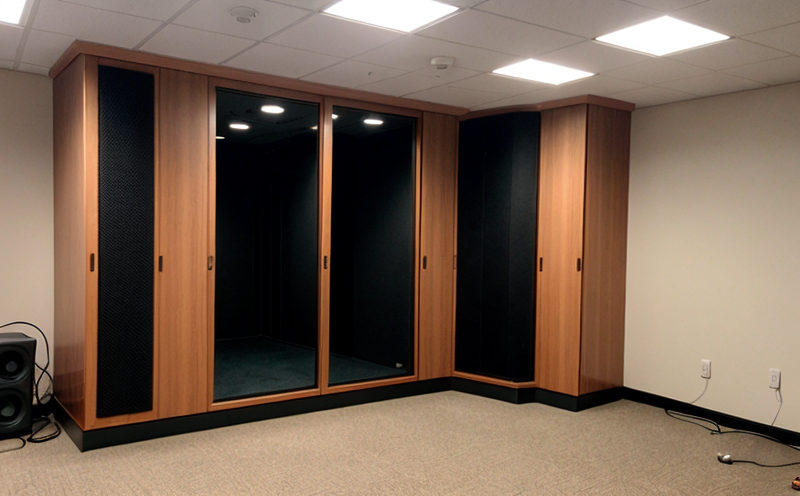ISO 1996-2 Environmental Noise Measurement Instrument Verification
The ISO 1996-2 standard is a cornerstone in the field of environmental noise measurement, providing rigorous guidelines for the verification and calibration of sound level meters. This service ensures that the instruments used to measure ambient noise levels are accurate and reliable, which is crucial for compliance with environmental regulations and ensuring public health.
Environmental noise can have significant impacts on human health and well-being, including sleep disturbance, stress, and cardiovascular disease. Accurate measurement of noise pollution is essential for effective management and mitigation strategies. The ISO 1996-2 standard establishes a procedure to verify the accuracy of sound level meters used in environmental noise monitoring.
The process involves a series of tests that include frequency response, stability, linearity, and sensitivity checks. These tests are conducted using calibrated test signals generated by a primary reference instrument. The results from these tests are compared against predetermined acceptance criteria specified in ISO 1996-2 to determine if the sound level meter is fit for use.
The accuracy of noise measurement instruments directly influences the effectiveness of regulatory compliance and public health initiatives. Inaccurate measurements can lead to incorrect assessments, which could result in ineffective policies or unnecessary interventions. Therefore, regular verification of these instruments using standards like ISO 1996-2 is essential.
Our laboratory adheres strictly to this standard, ensuring that every instrument we calibrate meets the highest quality and accuracy standards. This commitment translates into reliable data and informed decision-making for our clients. Whether you are a regulatory body or an R&D engineer looking to ensure the integrity of your noise measurement instruments, our service is tailored to meet your needs.
Our expertise in this area allows us to provide not only compliance with ISO 1996-2 but also additional value-added services such as instrument training and best practice guidance. By leveraging our extensive experience and state-of-the-art facilities, we can offer a comprehensive solution that goes beyond mere calibration.
Why It Matters
The accurate measurement of environmental noise is critical for public health and regulatory compliance. Noise pollution has been linked to various negative health outcomes, including increased stress levels, sleep disturbances, and cardiovascular disease. Therefore, the accuracy of the instruments used to measure this noise cannot be overstated.
Inaccurate measurements can lead to flawed assessments, which may result in ineffective policies or unnecessary interventions. By ensuring that sound level meters are verified against ISO 1996-2 standards, we help our clients achieve reliable and repeatable results. This reliability is essential for making informed decisions about noise control measures.
Moreover, compliance with these standards not only ensures legal adherence but also enhances the credibility of your organization. Clients who use calibrated instruments can have confidence in their data, which can lead to more effective environmental management strategies.
In summary, our ISO 1996-2 service is vital for maintaining high standards of accuracy and reliability in noise measurement. It supports regulatory compliance, public health initiatives, and informed decision-making.
Scope and Methodology
| Parameter | Description | Acceptance Criteria |
|---|---|---|
| Frequency Response | The range of frequencies that the instrument can accurately measure. | +/- 1 dB from 20 Hz to 12.5 kHz |
| Stability | The consistency of measurements over a specified period. | Change in noise level < 1 dBA per day for at least 3 days |
| Linearity | The relationship between the input signal and the instrument's output response. | Within ±0.5 dBA of a straight line through zero to full scale |
| Sensitivity | The ability of the instrument to detect low-level signals. | Absolute value < 1 dBA for a 60 dBA signal |
| Step | Description |
|---|---|
| Setup | The instrument is placed in a sound chamber with calibrated noise sources. |
| Data Collection | Noise levels are measured using the instrument and compared against known values. |
| Evaluation | The results are analyzed to determine compliance with ISO 1996-2 criteria. |
| Reporting | A detailed report is generated summarizing the findings and recommendations for adjustments if necessary. |
Eurolab Advantages
Our ISO 1996-2 service offers several advantages that set us apart from other calibration laboratories. Firstly, we employ highly qualified and experienced technicians who are trained in the latest techniques and best practices for instrument verification.
We have invested heavily in state-of-the-art equipment to ensure accurate and reliable calibrations. Our advanced facilities provide a controlled environment where instruments can be tested under consistent conditions, leading to more precise results.
Our comprehensive service goes beyond mere calibration. We also offer training sessions for your personnel on the correct use of noise measurement instruments. This ensures that your staff are well-equipped to maintain instrument accuracy over time.
We pride ourselves on our commitment to customer satisfaction. Our flexible scheduling allows you to choose a time that suits your operational needs, and we provide prompt turnaround times for calibration reports. Additionally, we offer ongoing support services to help you maintain compliance with ISO 1996-2 standards.
Choose Eurolab for your ISO 1996-2 verification needs. We are dedicated to providing high-quality service that meets the highest industry standards.





